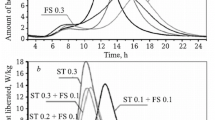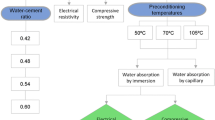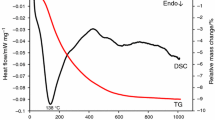Results are provided for a study of the properties of a cement matrix of medium-cement heat-resistant concrete with deflocculant additions, i.e., sodium tripolyphosphate and polycarboxylate ester. The effect of amount of deflocculant and heat treatment temperature on the change in matrix hydration product composition after hardening at 20°C and drying at 60, 80, and 110°C is considered. Comparative analysis is performed for the change in concrete physicomechanical properties and their heat resistance is evaluated in relation to amount and type of deflocculant.







Similar content being viewed by others
References
P. Vasilik, “New dispersants (deflocculants) for the production of refractory concretes,” Novye Ogneupory, No. 8, 28 – 30 (2003).
H. Hommer and K. Wutz, “Recent developments in deflocculants for castables,” 9th Biennial Worldwide Congress on Refractories (2006).
S. Monosi, R. Troli, and M. Collepardi, “High alumina cement-silica fume mixtures in the presence of superplasticizers. Superplasticizers and other chemical admixtures in concrete,” Proc. fifth CANMET / ACI International Conference, Rome, Italy (1997).
H. Hommer and J. von Seyerl, “The effect of polycarboxylate ethers as deflocculants in microsilica containing castables,” //Published in: Proc. 10th Biennial Worldwide Congress on Refractories, UNITECR 07, Dresden, Germany, September 18 – 21, 2007.
H. Uchikawa, S. Hanehara, and D. Sawaki, “The role of steric repulsive force in the dispersion of cement particles in fresh paste prepared with organic admixture,” Cement and Concrete Research, 27(1), 37 – 50 (1997).
I. Pundiene, V. Antonovich, R. Stonys, et al., “The effect of deflocculants on the structure and physical-mechanical properties of fireclay refractory castables,” Mat. Sci., 18(4), 390 – 395 (2012).
S. Goberis, I. Pundiene, and V. Antonovich, “The effect of sodium tripolyphosphate on the properties of medium-cement refractory castables based on Gorkal-40 cement,” Refr. Industr. Ceram., 46(6), 403 – 408 (2005).
G. Routschka, D. M. Daichennolt, and K. Wutz, “New plasticizer for ultralow cement (ULCC) andalusite and bauxite castables,” Interceram., 49(5), 356 – 359 (2000).
I. Pundienë, V. Antonovich, R. Stonys, and I. Demidova-Buizinene, “Development of refractory concrete for extreme conditions,” 5th Baltic conference on silicate materials (BaltSilica), 23 – 25 May 2011, Riga, Latvia. IOP Conference Series : Materials Science and Engineering Bristol : IOP Publishing Ltd., 25, 1 – 9 (2011).
K. Wutz, “Advanced polymers for monolithic refractories,” Publ. Proc. Biennial Worldwide Congress on Refractories, UNITECR 2001.
S. Goberis, V. Antonovich, I. Pundiene, and R. Stonis, “Effect of the quality of microsilica on the flow properties of cement slurry and characteristics of low-cement refractory concrete on a chamotte filler,” Refr. Industr. Ceram., 48(2), 123 – 127 (2007).
V. Antonovich, S. Goberis, I. Pundienë, and R. Stonis, “A new generation of deflocculants and microsilica used to modify the properties of a conventional refractory based on a chamotte filler,” Refr. Industr. Ceram., 47(3), 178 – 182 (2006).
S. Otroj, R. Mazban, M. Adibi, and K. Nikoo, “The factors of influence on the properties of alumina-spinel self-flowing castables,” 48th Internat. colloquium on Refractories, Aañhen (2005).
J. von Seyerl, “Influence of temperature and deflocculant on the handing properties of the high density, high alumina castables,” Refractory Manual, 62 – 65 (2008).
H. Hommer and K. Wutz, “The effect of organic deflocculants in castables,” Proc. Techn. Assoc. Refract., TARJ, Japan, Taikabutsu, 58(5), 248 – 255 (2006).
T. Bier and C. Parr, “Admixtures with calcium aluminate cements and CAS based castables,” Lafarge Aluminates: presented at the 28th Annual SACeram. Soc. Symp., Johannesburg (1996).
C. Parr and E. Spreafico, “Calcium aluminate cements (CAC) for monolithic refractories,” 1st Monolithic conference, Tehran (1997).
A. Mathieu, “Aluminous cement with high alumina content and chemical binders,” Presented at “Engineering and Use of Monolithic Refractories South Africa” (1993).
H. Peng, B. Myhre, and J. Olaf Roszinski, “Influence of microsilica on properties of bauxite-based castables,” Elkem Materials A/S.
I. Pundiene, S. Goberis, V. Antonovich, and R. Stonis, “Study of the possible application of low quality microsilica in medium cement heat-resistant concrete with deflocculant Castament FS 20,” Refr. Industr. Ceram., 48(4), 298 – 302 (2007).
J. Ding, Y. Fu, J. J. Beaudoin, “Effect of different inorganic salts / alkali on conversion-prevention in high alumina cement products,” Advanced Cement Based Materials, No. 4, 43 – 47 (1996).
S. Marcdargent, M. Testud, J. P. Bayoux, and A. Mathieu, “Hydration and strength of blends CAC-fume silica and stability of hydrates,” Proc. 9th Internat. Congr. on the Chemistry of Cement, vol. W; New Delhi, India (1992).
S. A. Rodger and D. Double, “The chemistry of hydration of high alumina cement in the presence of accelerating and retarding admixtures,” Cement and Concrete Research, 14(1), 73 – 82 (1984).
R. N. Edmonds and A. J. Majumdar, “The hydration of mixtures of monocalcium aluminate and blast furnace slag,” Cement and Concrete Research, 19(5), 779 – 782 (1989).
V. Antonoviè, M. Ðukðta, I. Pundienë, and R. Stonys, “Procedural elements in estimation of the thermal shock resistance of different types of refractory concrete based on chamotte filler,” Refr. Industr. Ceram., 52(1), 70 – 74 (2011).
H Taylor, Cement Chemistry [Russian translation], Mir, Moscow (1996).
S. Moehmel,W. Gessner, T. Bier, and C. Parr, “The Influence of microsilica on the course of hydration monocalcium aluminate,” Calcium Aluminate Cements 2001. Proc. Internat. Conf. on Calcium Aluminate Cements (CAC) Held at Heriot-Watt University Edinburg, Scotland, UK, 16 – 19 July 2001.
D. Garsel, J. Heijden, R. Kockegey-Lorenz, and G. Kriechbaum, “New developments in calcium aluminate cements and in dispersing aluminas for microsilica-containing castable systems,” Presented at XIII Conf. on Refractories, Prague, 28 – 29.03.2000.
B. Monsen and A. Seltveit, “Effect of microsilica on physical properties and mineralogical composition of refractory concretes published in advances in ceramics,” New Developments in Monolithic Refractories, Elkem Materials, 13 (1984).
Y. Fu, J. Ding, and J. Beaudoin, “Mechanisms of strätlingite formation in high alumina cement — siliceous material systems,” Accepted for proc. 2nd CANMET / ACI Intl. Sym., Las Vegas, USA, June 11 – 14, 1995.
S. Bentsen, A. Seltveit, and B. Sandberg, “Effect of Elkem Microsilica on conversion of HAC,” Presented at the Midgley Symp. on Calcium Aluminate Cement, London, 9 – 11 July, 1990.
V. Antonoviè, J. Kerienë, R. Boris, and M. Aleknevièius, “The effect of temperature on the formation of the hydrated calcium aluminate cement structure,” Procedia Engineering, 57, 99 – 106 (2013).
K. Quillin, G. Osborne, A. Majumdar, and B. Singh, “Effects of w/c ratio and curing conditions on strength development in BRECEM concretes,” Cement and Concrete Research, 31, 627 – 632 (2001).
A. J. Majumdar, B. Singh, and R. N. Edmonds, “Hydration of mixtures of ‘Ciment Fondu’ aluminous cement and granulated blast furnace slag,” Cement and Concrete Research, 20, 197 – 208 (1990).
Author information
Authors and Affiliations
Corresponding author
Additional information
Translated from Novye Ogneupory, No. 3, pp. 134 – 141, March, 2014.
Rights and permissions
About this article
Cite this article
Demidova-Buizinene, I., Pundiene, I. Effect of Amount of Deflocculant on Change in Physicomechanical Properties of Medium-Cement Heat-Resistant Concretes During Drying and Heat Treatment. Refract Ind Ceram 55, 121–127 (2014). https://doi.org/10.1007/s11148-014-9673-4
Received:
Published:
Issue Date:
DOI: https://doi.org/10.1007/s11148-014-9673-4




